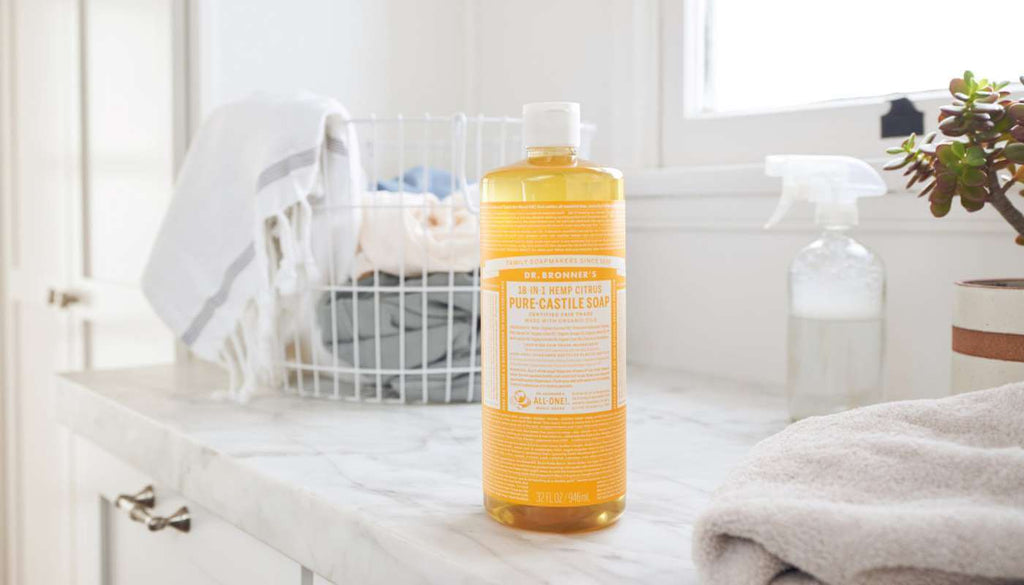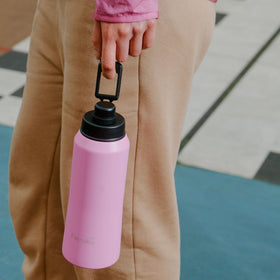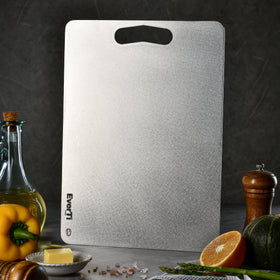Pure Liquid Soap vs Detergent: What You Need to Know
Difference between liquid castile soap and other liquid soap
I was chatting to a customer this week about castile liquid soap, and she asked a very good question. What is the difference between pure castile liquid soap and other liquid soaps?
What is castile soap?
Castile soaps are made from vegetable oil, rather than animal fats or synthetics. They originally came from Spain, from the Castile region. Castile soaps always used to be made with olive oil, but nowadays they can be made with any plant-based fat. You’ll find organic coconut oil, organic hemp oil, organic jojoba oil, organic olive oil, organic palm kernel oil, and more.
Castile soaps come in both solid and liquid forms. Taking Dr Bronner’s as an example, you’ll find that their range includes bar soaps and liquid soaps. Both of these are castile soaps. The difference between a bar and a liquid castile soap is the chemical that’s used to change the fat into soap. This process is called saponification.

Image source: Dr Bronner
Benefits of Castile Soap
Castile soap is a natural and versatile cleaning agent that offers numerous benefits for the skin, hair, and environment. Some of the key benefits of castile soap include:
-
Gentle and Non-Irritating: Made from natural ingredients, castile soap is free from harsh chemicals, making it an excellent choice for sensitive skin and acne-prone skin. Its gentle formula ensures that it cleanses without causing irritation.
-
Moisturizing: Rich in olive oil, coconut oil, and other natural oils, castile soap helps to moisturize and nourish the skin. These oils provide essential fatty acids that keep the skin hydrated and soft.
-
Anti-Inflammatory: Castile soap has anti-inflammatory properties that can help to soothe and calm irritated skin. This makes it a great option for those with conditions like eczema or psoriasis.
-
Antibacterial: The natural antibacterial properties of castile soap can help to prevent the growth of bacteria and other microorganisms on the skin, promoting a healthier complexion.
-
Environmentally Friendly: Castile soap is biodegradable and free from synthetic preservatives, making it a more environmentally friendly option compared to traditional soaps. It breaks down easily in the environment, reducing its impact on ecosystems.
How are soaps made?
Soap needs three basic ingredients: animal or plant oil, water and lye. When these are mixed together in the right proportions, a chemical reaction called saponification takes place, and you have soap.
Liquid soaps use potassium hydroxide to saponify, and bar soaps use sodium hydroxide (lye). Although the potassium hydroxide and sodium hydroxide are both highly caustic, the chemical process of saponification completely removes these chemicals. Through the magic of chemistry, you’re left with a mixture of water, soap and glycerin.
Citric acid is often added to enhance the quality and effectiveness of the soap.
Castile soaps are pure, safe and can be formulated with extra oils to make them moisturising, rather than drying, on your skin. Adding the extra oils is called superfatting.
What are other soaps made from, including organic olive oil?
Whereas a castile soap is made from plant based fats and oils, other natural soaps are made from animal fats like lard or tallow.
If a liquid soap isn't made with either plant or animal based fats, they're not soaps at all, they're detergents. Detergents are different to soaps in that they're often synthetic and they work slightly differently.
What is a detergent? A detergent is based on surfactants, which are generally synthetic, but can also be derived from natural sources (cocamidopropyl betaine is derived from coconuts, for example). This doesn't make them natural, as they're still heavily processed, but they do come from natural sources.
How to tell the difference between soaps and detergents?
Liquid soaps will list potassium hydroxide, bar soaps will list sodium hydroxide in their ingredients lists. Detergents will use some kind of surfactant. These might be naturally derived, like cocoamidopropyl betaine or polyglucoside. Or they could be synthetic, like sodium lauryl sulfate (SLS).
So if you're seeing ‘soaps' with surfactants in them, they're actually detergents. Generally, shower gels, liquid hand soaps are detergents rather than soaps.
Key Differences Between Castile Soap and Detergent
Castile soap and detergent are two different types of cleaning agents that have distinct differences in terms of their ingredients, properties, and uses. Some of the key differences between castile soap and detergent include:
-
Ingredients: Castile soap is made from natural ingredients such as olive oil, coconut oil, and essential oils. In contrast, detergents are made from synthetic chemicals and surfactants, which can be harsher on the skin.
-
pH Level: Castile soap has a higher pH level than detergent, making it more alkaline and gentle on the skin. This higher pH level helps to maintain the skin’s natural balance without stripping away its natural oils.
-
Foaming: Castile soap produces a rich, creamy lather that feels luxurious on the skin. On the other hand, detergents produce a lot of foam but can strip the skin of its natural oils, leading to dryness and irritation.
-
Uses: Castile soap is incredibly versatile and can be used as a body wash, shampoo, hand soap, and even as a cleaning agent for surfaces. Detergents, however, are primarily used for washing clothes and cleaning surfaces due to their strong cleaning power.
Should you use a soap or a detergent?
Castile soaps are made from natural ingredients, that are pretty simple, and break down easily in the environment. There are lots of ways you can use castile soaps, so you can cut down on the amount of products that you’re using.
However, if you’re in an area that has hard water, you may find that castile soap leaves an oily residue on surfaces like bathtubs, which can be a potential drawback. The high amount of calcium and other minerals in hard water reacts with the soap to form a scum. This inhibits the surfactant properties, so it doesn’t foam up as easily. You use more soap to make up for this and end up with a film of scum on your tiles and sink. You’ll probably find that using a detergent based cleanser designed for hard water areas will give you a better result.
Choosing the Right Castile Soap
With so many different types of castile soap available, it can be overwhelming to choose the right one for your needs. Here are some tips to help you choose the right castile soap:
-
Look for Organic and Natural Ingredients: Choose a castile soap that is made from organic and natural ingredients, such as olive oil, coconut oil, and essential oils. These ingredients ensure that the soap is gentle and nourishing for your skin.
-
Consider Your Skin Type: If you have sensitive skin, look for a castile soap that is fragrance-free and hypoallergenic. For acne-prone skin, opt for a castile soap that contains tea tree oil or other antibacterial ingredients to help combat breakouts.
-
Check the pH Level: Choose a castile soap that has a pH level close to the natural pH of the skin, which is around 5.5. This helps to maintain the skin’s natural barrier and prevents dryness.
-
Read Reviews and Do Research: Read reviews from other customers and do research on the company to ensure that you are buying a high-quality castile soap. This can help you find a product that meets your specific needs and preferences.
Castile Soap vs Dish Soap
Can you use pure castile liquid soap to wash dishes? The short answer is yes. However, if you’re in a hard water area, you may find that using castile soap on dishes leaves a soap scum.
If you’re a fan of Dr Bronner’s like I am, you may want to use their Sal Suds instead. This is a detergent, not a castile soap.
You may also find that soap irritates sensitive skin, especially facial skin. Finding a sensitive skin cleanser that is detergent based might be a better choice. This is why you’ll sometimes see products that are advertised as being ‘soap free’.
It also depends on what you’re using the product for. You may choose to use a castile soap for personal cleansing, but stick to detergents for household cleaning. (Although Dr Bronner does say there are at least 18 uses for castile soap!).
The key, as always, is to read the ingredients on the back of the label. Ignore the marketing claims on the front and find out what’s really in the products that you’re using.
Uses for Castile Soap
Castile soap is a versatile cleaning agent that can be used in a variety of ways. Here are some of the most common uses for castile soap:
-
Body Wash: Castile soap can be used as a body wash to clean and moisturize the skin. Its gentle formula makes it suitable for all skin types, including sensitive skin.
-
Shampoo: Castile soap can be used as a shampoo to clean and nourish the hair. It helps to remove buildup and leaves the hair feeling soft and manageable.
-
Hand Soap: Castile soap can be used as a hand soap to clean and moisturize the hands. Its natural ingredients ensure that it is gentle on the skin, even with frequent use.
-
Cleaning Agent: Castile soap can be used as a cleaning agent for surfaces, such as countertops, sinks, and floors. Its powerful cleaning properties make it effective at removing dirt and grime.
-
Laundry Detergent: Castile soap can be used as a laundry detergent to wash clothes and clean fabrics. It is a natural and eco-friendly alternative to traditional laundry detergents.
By incorporating these new sections, the article will provide a comprehensive guide on the differences between castile soap and detergent, as well as the benefits and uses of castile soap.
FAQs about Castile Soap
Is castile soap sulfate free?
Pure castile soap is made from animal or vegetable oil, an alkali (either sodium hydroxide or potassium hydroxide) and water. That means that it's sulfate free.
Is there a difference between glycerin soap vs castile soap?
Not really. All real soaps are glycerin soaps, as glycerin is produced as part of the soap making process. Transparent soaps are often confused with glycerin soaps, but it's just real soap where sugar and alcohol are added to stop the soap crystals from turning opaque. When it doesn't crystallise, the soap stays clear.










